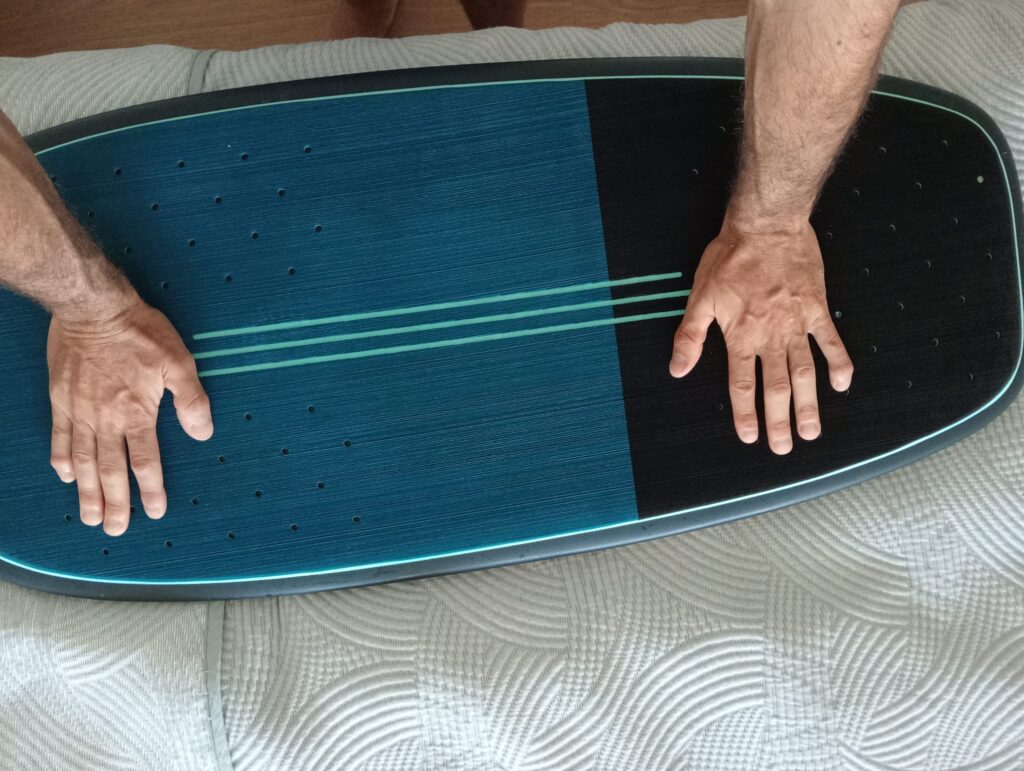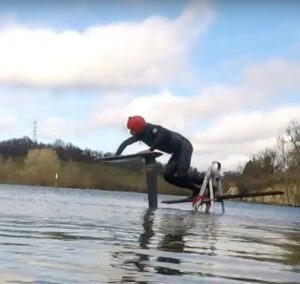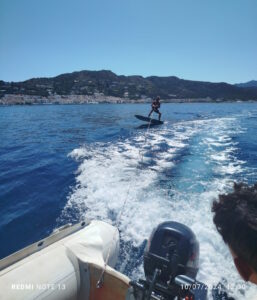To ride the board you have to put the foot that is most comfortable for you in front, whether you are regular (left foot in front) or goofy (right foot in front). You will already know this if you have skated, surfed or snowboarded, otherwise go skate in socks down the hall at home and see which foot in front is most comfortable for you.
To run down the pier some people grab the board from the side, I prefer to run with my hands already prepared on the board to push myself and start to exert some pressure on the board. I think it is better if you start to feel with your hands that the foil starts to work.
It is usually said to place your hands where you want to place your feet, but in my case at the beginning I always ended up putting my feet a little further back than where my hands are. So record yourself on video, see where your feet go, and correct the position of your hands accordingly.
The position of your feet depends on the board, the foil, your size… you will have to find the ideal position based on the results, but as a general rule the back foot will be just over the front of the mast and the front foot at shoulder distance.
Your hands should be in the center of the board, but it is not the center of your hand that should be in the center of the board, but the center of the palm, which is really where you exert the most pressure to get on. The rest of your hand will go to the side of the board that is furthest away. If you put the center of your hand in the center of the board you will be able to get on but it is very likely that your feet will not end up centered.
If your board doesn’t have reference marks to show the exact position of your hands in one jump and another, paint them on it somehow. It’s important to try out different hand positions so that you can see which position works best for you, and session by session you’ll be fine-tuning that position, so you need a clear reference. These marks will also be useful when you watch the position of your feet on video, so you’ll be able to identify their position more quickly in relation to the reference.

Place your hands and run, giving it all the speed you can. When you know how to do it well, you won’t need much speed, but right now, since you don’t know how to pump, the more speed you give, the longer you’ll stay on the board and the more time you’ll use to get the feel for the board.
Example of going out at low speed:
Example of a similar level but coming out at high speed:
When you get on the board, you should try to put your feet down at almost the same time, but if one goes half a second before the other, the back foot should go first.
At this point, you will go into the water anyway because it will be rare for you to place your feet correctly, but the beginning is hard. For this initial jump, the ideal is to make the minimum jump to place your feet on the board, giving the board a final push with your feet to give it even more speed. Anything more you jump on the board will be wasted energy and the board will push down even more when landing.
Just as you put your feet on the board, look at the board, find the center of the board to position your feet correctly. If your board doesn’t have a mark where you can see the center, draw one on it. But this glance only lasts a second, really by the time your feet are on the board you should already be looking forward.
You can practice this jump at home by placing the board on an armchair or bed, so you build muscle memory.
This goal is difficult, to give you an example in my 13th session, I managed to do 6 good jumps out of 10. And by the 15th, 9 out of 10 were good. And every time you change board or foil you will have to do trial and error tests again to find the ideal hand position
Jumping well every time is almost impossible, the jumps will not come out 100% until you are able to correct your feet once you are on the board. And you will not be able to do this until you know how to pump correctly, since your feet move when you go up when you are lifted on the board. But don’t be in a hurry, everything will come and now it is time to jump and fall many times.
Example of commented jump:
Example of a jump seen from above
Example leaning on fingers to bend less
When the dock is high or the mast is short, we have to run more bent over, one way to bend less is to support only the fingers on the board



